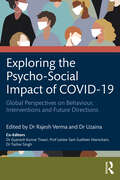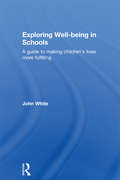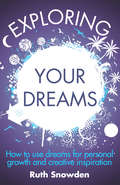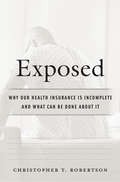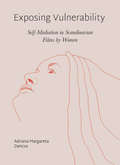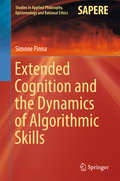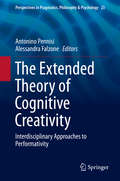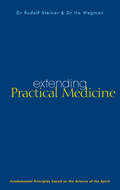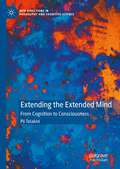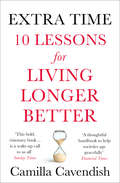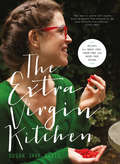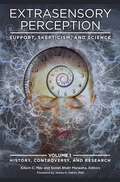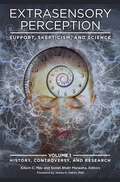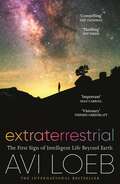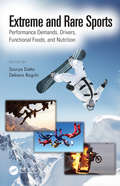- Table View
- List View
Exploring the Psycho-Social Impact of COVID-19: Global Perspectives on Behaviour, Interventions and Future Directions
by Rajesh Verma UzainaThis comprehensive resource provides a one-stop information repository, exploring all psychological aspects of Covid-19. Divided into three sections, the book covers the psycho-social impact on society and individuals and our collective cooperative behaviour, as well as philanthropic efforts, coping strategies and technological interventions, and how lessons learned will help in preparedness for the future. Including case studies and the latest research from diverse scientific studies across different regions, this book examines how psycho-social paradigms changed as a result of the pandemic, and left their watermark on the human psyche. It also explores the coping strategies adopted to deal with this common aggressor and how the techniques varied in accordance with social, cultural and geographical factors. The final section offers new insights for the future, highlighting the psychological infrastructure required, the type of preparedness and handling strategies necessary to mitigate the impact of any future biogenic pandemics. Combining theory and practical application, this is a valuable reading for academics and researchers as well as practising psychologists, clinical psychologists, and law-makers who are concerned with mental health.
Exploring the Psycho-Social Impact of COVID-19: Global Perspectives on Behaviour, Interventions and Future Directions
This comprehensive resource provides a one-stop information repository, exploring all psychological aspects of Covid-19. Divided into three sections, the book covers the psycho-social impact on society and individuals and our collective cooperative behaviour, as well as philanthropic efforts, coping strategies and technological interventions, and how lessons learned will help in preparedness for the future. Including case studies and the latest research from diverse scientific studies across different regions, this book examines how psycho-social paradigms changed as a result of the pandemic, and left their watermark on the human psyche. It also explores the coping strategies adopted to deal with this common aggressor and how the techniques varied in accordance with social, cultural and geographical factors. The final section offers new insights for the future, highlighting the psychological infrastructure required, the type of preparedness and handling strategies necessary to mitigate the impact of any future biogenic pandemics. Combining theory and practical application, this is a valuable reading for academics and researchers as well as practising psychologists, clinical psychologists, and law-makers who are concerned with mental health.
Exploring Well-Being in Schools: A Guide to Making Children's Lives more Fulfilling
by John Peter WhiteCan we teach others how to lead a fulfilling life? The notion of personal well-being has recently shot up the political and educational agendas, placing the child's well-being at the heart of the school’s task. With his renowned talent for distilling the most complex of philosophical arguments into accessible laymen's terms, John White addresses the maze of issues surrounding well-being, bringing clarity to this dissension and confusion. This accessible book expertly guides you through the conflicting perspectives on well-being found in the educational world by * Examining religious and secular views of human fulfilment and of a meaningful life. * Analysing the appeal of celebrity, wealth and consumerism to so many of our children. * Asking what role pleasure, success, autonomy, work, life-planning and worthwhile activities play in children's flourishing. * Showing how proposals to encourage children's well-being impact on schools' aims and learning arrangements. Whether you have little background in education and philosophy or are reading as a teacher, student or policy maker, this engaging book will take you right to the heart of these critical issues. It will leave you with a sharply-focused picture of a remodelled educational system fit for our new millennium, committed to helping every child to enjoy a fulfilling life.
Exploring Well-Being in Schools: A Guide to Making Children's Lives more Fulfilling
by John Peter WhiteCan we teach others how to lead a fulfilling life? The notion of personal well-being has recently shot up the political and educational agendas, placing the child's well-being at the heart of the school’s task. With his renowned talent for distilling the most complex of philosophical arguments into accessible laymen's terms, John White addresses the maze of issues surrounding well-being, bringing clarity to this dissension and confusion. This accessible book expertly guides you through the conflicting perspectives on well-being found in the educational world by * Examining religious and secular views of human fulfilment and of a meaningful life. * Analysing the appeal of celebrity, wealth and consumerism to so many of our children. * Asking what role pleasure, success, autonomy, work, life-planning and worthwhile activities play in children's flourishing. * Showing how proposals to encourage children's well-being impact on schools' aims and learning arrangements. Whether you have little background in education and philosophy or are reading as a teacher, student or policy maker, this engaging book will take you right to the heart of these critical issues. It will leave you with a sharply-focused picture of a remodelled educational system fit for our new millennium, committed to helping every child to enjoy a fulfilling life.
Exploring Your Dreams: How to use dreams for personal growth and creative inspiration
by Ruth SnowdenUse this dream handbook to decode hidden aspects of your psyche, as well as to inspire you to grow and achieve personal goalsDreams are an integral part of who we are and carry valuable messages. They can reveal our true selves, unmasking our fears, hostilities, hidden talents and desires. Enabling us to explore and learn from hidden aspects of the psyche, dreams can teach you a lot about yourself and others, helping you with problems and guiding you throughout your life. This book gives advice and guidance on exploring and interpreting your dreams, and using them for personal and creative development. It includes:* The place of dreams in human culture. * How to prepare for, and how to record your dreams. * Dream analysis, including common dream types and the strange but powerful world of symbolism. * Advanced dream exploration, including joining a dream group and working with others.
Exposed: Why Our Health Insurance Is Incomplete and What Can Be Done about It
by Christopher T. RobertsonDemocrats and Republicans fight endlessly over health care, but neither side disputes one of the system’s most basic flaws: the foisting on patients of substantial costs through deductibles, copayments, and coinsurance. Marshalling a decade of research, Christopher Robertson shows why this model is dysfunctional and offers ideas for improvement.
Exposing Vulnerability: Self-Mediation in Scandinavian Films by Women
by Adriana DancusThis book explores the diversity of perspectives afforded by the emerging body of Scandinavian films produced by women. The author focuses on women filmmakers' use of their own vulnerability in representing Scandinavian experiences with globally relevant contemporary issues such as race, gender, mental illness, bullying and the trauma of migration, and highlights the frictions between the positive and negative manifestations of such vulnerability. Though Scandinavia is reputed for its ambitious and innovative film tradition, film scholarship has largely ignored women’s bold contributions to the canon. Exposing Vulnerability is a cultural and socio-political analysis of contemporary film by Scandinavian women as they use their lives and work to reconfigure the cinematic, the political and the ethical.
Extended Cognition and the Dynamics of Algorithmic Skills (Studies in Applied Philosophy, Epistemology and Rational Ethics #35)
by Simone PinnaThis book describes a novel methodology for studying algorithmic skills, intended as cognitive activities related to rule-based symbolic transformation, and argues that some human computational abilities may be interpreted and analyzed as genuine examples of extended cognition. It shows that the performance of these abilities relies not only on innate neurocognitive systems or language-related skills, but also on external tools and general agent–environment interactions. Further, it asserts that a low-level analysis, based on a set of core neurocognitive systems linking numbers and language, is not sufficient to explain some specific forms of high-level numerical skills, like those involved in algorithm execution. To this end, it reports on the design of a cognitive architecture for modeling all the relevant features involved in the execution of algorithmic strategies, including external tools, such as paper and pencils. The first part of the book discusses the philosophical premises for endorsing and justifying a position in philosophy of mind that links a modified form of computationalism with some recent theoretical and scientific developments, like those introduced by the so-called dynamical approach to cognition. The second part is dedicated to the description of a Turing-machine-inspired cognitive architecture, expressly designed to formalize all kinds of algorithmic strategies.
The Extended Theory of Cognitive Creativity: Interdisciplinary Approaches to Performativity (Perspectives in Pragmatics, Philosophy & Psychology #23)
by Antonino Pennisi Alessandra FalzoneThis edited volume focuses on the hypothesis that performativity is not a property confined to certain specific human skills, or to certain specific acts of language, nor an accidental enrichment due to creative intelligence. Instead, the executive and motor component of cognitive behavior should be considered an intrinsic part of the physiological functioning of the mind, and as endowed with self-generative power. Performativity, in this theoretical context, can be defined as a constituent component of cognitive processes. The material action allowing us to interact with reality is both the means by which the subject knows the surrounding world and one through which he experiments with the possibilities of his body. This proposal is rooted in models now widely accepted in the philosophy of mind and language; in fact, it focuses on a space of awareness that is not in the individual, or outside it, but is determined by the species-specific ways in which the body acts on the world. This theoretical hypothesis will be pursued through the latest interdisciplinary methodology typical of cognitive science, that coincide with the five sections in which the book is organized: Embodied, enactivist, philosophical approaches; Aesthetics approaches; Naturalistic and evolutionary approaches; Neuroscientific approaches; Linguistics approaches. This book is intended for: linguists, philosophers, psychologists, cognitive scientists, scholars of art and aesthetics, performing artists, researchers in embodied cognition, especially enactivists and students of the extended mind.
Extending Practical Medicine: Fundamental Principles Based on the Science of the Spirit
by Rudolf Steiner Dr. Ita WegmanIn this classic introductory work on spiritual medicine, Rudolf Steiner worked in unique literary collaboration with the physician Ita Wegman. Their aim was to revitalise the art of healing through spiritual knowlege - yet in so doing they did not underrate or dismiss modern scientific medicine, but illumined it beyond its present materialistic outlook to a fuller realisation of the human condition.As Ita Wegman wrote in her preface: "The aim was not to underestimate scientific medicine in an ameteurish way; it was given full recognition. But it was important to add to existing knowlege the insights that can come from true perception of the spirit, enabling us to understand the processes of illness and healing."Today this new extension of practical medicine, known as 'anthroposophical medicine', is used and valued by many physicians and in many clinics around the world.Dr. ITA WEGMAN was born in the Dutch West Indies in 1876 and trained in gymnastics and massage and later medicine. After founding the Institute of Clinical Medicine in Arlesheim, she was made leader of the Medical Section of the Anthroposophical Society in 1923. Her last years were devoted to her work in the clinic where she died in 1943.
Extending the Extended Mind: From Cognition to Consciousness (New Directions in Philosophy and Cognitive Science)
by Pii TelakiviThis book argues that conscious experience is sometimes extended outside the brain and body into certain kinds of environmental interaction and tool use. It shows that if one accepts that cognitive states can extend, one must also accept that consciousness can extend. The proponents of Extended Mind defend the former claim, but usually oppose the latter claim. The most important undertaking of this book is to show that this partition is not possible on pain of inconsistency. Pii Telakivi presents three arguments for the hypothesis of Extended Conscious Mind, examines and answers the most common counterarguments, and introduces a novel means to interpret and apply the concept of constitution. She also addresses the tensions between analytic philosophy of mind and enactivism, and builds a bridge between two different traditions: on the one hand, extended mind, and on the other, enactivism and embodied mind—and maintains that a unifying approach is necessary for a theory about extended consciousness.
Extra Time: 10 Lessons For An Ageing Society - How To Live Longer And Live Better
by Camilla Cavendish‘An inspirational call to arms’ DAILY MAIL ‘This book is so sensible, so substantially researched, so briskly written, so clear in its arguments, that one wishes Baroness Cavendish was still whispering into the prime ministerial ear’ THE TIMES
The Extra Virgin Kitchen – The No.1 Bestseller: Everyday Healthy Recipes Free From Wheat, Dairy and Refined Sugar
by Susan Jane WhiteThe No.1 bestselling cookbook from sassy food revolutionary Susan Jane White, full of seriously tasty recipes for high energy and glowing health, all free from wheat, dairy and refined sugar.When Irish food writer Susan Jane White was advised to stay away from wheat, dairy and refined sugar during a debilitating illness, her food future seemed bleak, bland and boring. So, drawing on her gastronomic background, she created seriously tasty recipes that didn’t compromise her health. The result? Susan Jane’s energy levels went through the roof and her friends and family began to look for her ‘free-from’ recipes whether or not they had intolerances.Packed with Susan Jane’s delicious wheat-free, dairy-free and refined sugar-free recipes and full of invaluable advice for anyone starting out on their own health journey, The Extra Virgin Kitchen is your ideal kitchen companion. Funny, informative and full of personality, The Extra Virgin Kitchen will change how you cook, eat and view food forever. Get ready to embrace healthy eating and nutritious cooking – with no sacrifice to fun or flavour!‘If anyone ever needed proof that super-healthy food makes a huge difference to your energy levels, immune system and general vitality, then one look at the ever-effervescent Susan Jane White would tell you everything you need to know.’ Bestselling chef Rachel Allen‘Do you and your body a favour – read this book. Susan Jane White knows what's good for you and it doesn't hurt that she writes like a dream.’ Róisín Ingle, The Irish Times‘Hilariously written and filled with do-able and exciting new recipes.’ Food writer and TV personality Donal SkehanAlso by Susan Jane White: The Virtuous Tart – Sinful but Saintly Recipes for Sweets, Treats and SnacksYou can watch Susan Jane in action on Jamie Oliver’s Drinks Tube YouTube channel.
Extrasensory Perception [2 volumes]: Support, Skepticism, and Science [2 volumes]
by Edwin C. May and Sonali Bhatt MarwahaScholars from around the world collaborate to explain the history of parapsychology, the study of extrasensory perception (ESP), and the arguments of skeptics and supporters in this fascinating collection.This two-volume set introduces ESP—also known as anomalous cognition—and psychokinesis, addressing the history, research, philosophy, and scientific theories surrounding the phenomena. With contributions from leading research scientists from within the field of parapsychology and other areas of study, this reference addresses the fundamental questions that the evidence of ESP evokes; examines parapsychology research from all over the world; and explores the controversies, skepticism, and contemporary criticism disparaging the field.Written for a multidisciplinary audience ranging from physicists to psychologists to lay persons, the volumes present the scientific validity of the field. Volume 1 addresses the historical, philosophical, skeptical, and research viewpoints; volume 2 lays out the current theories on ESP. Chapters reveal how strict scientific protocols and state-of-the-art technologies enable scientists—at sites such as Harvard and Cornell universities to their international counterparts in Amsterdam, Austria, and Asia—to pinpoint and investigate ESP abilities. Appendices include a glossary of key terms in parapsychology, ESP research protocol, ESP research organizations, skeptic associations, and recommended reading.
Extrasensory Perception [2 volumes]: Support, Skepticism, and Science [2 volumes]
by Edwin C. May Sonali Bhatt MarwahaScholars from around the world collaborate to explain the history of parapsychology, the study of extrasensory perception (ESP), and the arguments of skeptics and supporters in this fascinating collection.This two-volume set introduces ESP—also known as anomalous cognition—and psychokinesis, addressing the history, research, philosophy, and scientific theories surrounding the phenomena. With contributions from leading research scientists from within the field of parapsychology and other areas of study, this reference addresses the fundamental questions that the evidence of ESP evokes; examines parapsychology research from all over the world; and explores the controversies, skepticism, and contemporary criticism disparaging the field.Written for a multidisciplinary audience ranging from physicists to psychologists to lay persons, the volumes present the scientific validity of the field. Volume 1 addresses the historical, philosophical, skeptical, and research viewpoints; volume 2 lays out the current theories on ESP. Chapters reveal how strict scientific protocols and state-of-the-art technologies enable scientists—at sites such as Harvard and Cornell universities to their international counterparts in Amsterdam, Austria, and Asia—to pinpoint and investigate ESP abilities. Appendices include a glossary of key terms in parapsychology, ESP research protocol, ESP research organizations, skeptic associations, and recommended reading.
Extraterrestrial: The First Sign of Intelligent Life Beyond Earth
by Avi Loeb'VISIONARY' Stephen GreenblattHarvard's top astronomer takes us inside the mind-blowing story of the first interstellar visitor to our solar system In late 2017, scientists at a Hawaiian observatory glimpsed a strange object soaring through our inner solar system. Astrophysicist Avi Loeb conclusively showed it was not an asteroid; it was moving too fast along a strange orbit, and leaving no trail of gas or debris in its wake. There was only one conceivable explanation: the object was a piece of advanced technology created by a distant alien civilization. In Extraterrestrial, Loeb takes readers inside the thrilling story of the first interstellar visitor to be spotted in our solar system. He outlines his theory and its profound implications: for science, for religion, and for the future of our planet. A mind-bending journey through the furthest reaches of science, space-time, and the human imagination, Extraterrestrial challenges readers to aim for the stars-and to think critically about what's out there, no matter how strange it seems.
Extreme and Rare Sports: Performance Demands Drivers Functional Foods And Nutrition
by Sourya Datta Debasis BagchiTwo crucial components of a healthy life are nutrition and exercise. The importance of appropriate diet, food and nutrition are extremely important to be successful in sports, and, especially, in extreme sports. Extreme sport is an activity where a participant must demonstrate both mental and physical skills. This type of activity provides an adrenaline rush to individuals who are part of the "community of extreme sportsmen." Extreme sports provide opportunity for individuals to be active and fit with added enjoyment of partaking in a fun activity. Extreme sports in conjunction with proper nutrition helps to boost immunity and resistance against common infections. Studies have also exhibited that sports and exercise activities help in managing effective work-life balance as well. Extreme and Rare Sports: Performance Demands, Drivers, Functional Foods, and Nutrition provides a comprehensive treatise on extreme sports emphasizing the importance of nutrition and research-driven nutraceutical supplements in injury prevention and treatment. The book presents information on the nutritional requirements of sports activities on land, in water, or with high altitude-base. It covers a wide variety of definitions, philosophies, thoughts and practices involved with structurally diverse extreme sports. Features: Discusses specific food and nutritional requirements in extreme sports Provides information on the importance of functional foods, nutrition and structurally diverse phytonutrients for different sports Features information on Olympic and diverse extreme sports Details the importance of hydration and use of gelatin; skeletal muscle damage and recovery from eccentric contractions; and information on dietary supplements and antioxidants Presents analysis on growth, marketing, techniques, and future of extreme sports
Extreme and Rare Sports: Performance Demands, Drivers, Functional Foods, and Nutrition
by Sourya Datta Debasis BagchiTwo crucial components of a healthy life are nutrition and exercise. The importance of appropriate diet, food and nutrition are extremely important to be successful in sports, and, especially, in extreme sports. Extreme sport is an activity where a participant must demonstrate both mental and physical skills. This type of activity provides an adrenaline rush to individuals who are part of the "community of extreme sportsmen." Extreme sports provide opportunity for individuals to be active and fit with added enjoyment of partaking in a fun activity. Extreme sports in conjunction with proper nutrition helps to boost immunity and resistance against common infections. Studies have also exhibited that sports and exercise activities help in managing effective work-life balance as well. Extreme and Rare Sports: Performance Demands, Drivers, Functional Foods, and Nutrition provides a comprehensive treatise on extreme sports emphasizing the importance of nutrition and research-driven nutraceutical supplements in injury prevention and treatment. The book presents information on the nutritional requirements of sports activities on land, in water, or with high altitude-base. It covers a wide variety of definitions, philosophies, thoughts and practices involved with structurally diverse extreme sports. Features: Discusses specific food and nutritional requirements in extreme sports Provides information on the importance of functional foods, nutrition and structurally diverse phytonutrients for different sports Features information on Olympic and diverse extreme sports Details the importance of hydration and use of gelatin; skeletal muscle damage and recovery from eccentric contractions; and information on dietary supplements and antioxidants Presents analysis on growth, marketing, techniques, and future of extreme sports
Extreme ectomorph (Large Print)
by Rnib BookshareThis is an image of a tall and very thin man. There is a locator dot shown, which will be at the top left of the page when the image is the right way up. He has prominent cheeks, ribs and collar bones. He stands facing you with his head at the top centre of the page and feet at the bottom of the page. His arms are to the left and right of his body. The size and shape of his body can be clearly found as he is only wearing swimming trunks.
Extreme ectomorph (UEB Contracted)
by Rnib BookshareThis is an image of a tall and very thin man. There is a locator dot shown, which will be at the top left of the page when the image is the right way up. He has prominent cheeks, ribs and collar bones. He stands facing you with his head at the top centre of the page and feet at the bottom of the page. His arms are to the left and right of his body. The size and shape of his body can be clearly found as he is only wearing swimming trunks.
Extreme ectomorph (UEB Uncontracted)
by Rnib BookshareThis is an image of a tall and very thin man. There is a locator dot shown, which will be at the top left of the page when the image is the right way up. He has prominent cheeks, ribs and collar bones. He stands facing you with his head at the top centre of the page and feet at the bottom of the page. His arms are to the left and right of his body. The size and shape of his body can be clearly found as he is only wearing swimming trunks.
Extreme endomorph (Large Print)
by Rnib BookshareThis is an image of a man with a large amount of body fat indicated in places by short lines. There is a locator dot shown, which will be at the top left of the page when the image is the right way up. He has a large double chin and a large round stomach. He stands facing you with his head at the top centre of the page and feet at the bottom of the page. His arms are to the left and right of his body. The size and shape of his body can be clearly found as he is only wearing swimming trunks.
Extreme endomorph (UEB Contracted)
by Rnib BookshareThis is an image of a man with a large amount of body fat indicated in places by short lines. There is a locator dot shown, which will be at the top left of the page when the image is the right way up. He has a large double chin and a large round stomach. He stands facing you with his head at the top centre of the page and feet at the bottom of the page. His arms are to the left and right of his body. The size and shape of his body can be clearly found as he is only wearing swimming trunks.
Extreme endomorph (UEB Uncontracted)
by Rnib BookshareThis is an image of a man with a large amount of body fat indicated in places by short lines. There is a locator dot shown, which will be at the top left of the page when the image is the right way up. He has a large double chin and a large round stomach. He stands facing you with his head at the top centre of the page and feet at the bottom of the page. His arms are to the left and right of his body. The size and shape of his body can be clearly found as he is only wearing swimming trunks.
Extreme mesomorph (Large Print)
by Rnib BookshareThis is an image of a broad shouldered man with well developed muscles. There is a locator dot shown, which will be at the top left of the page when the image is the right way up. He stands facing you with his head at the top centre of the page and feet at the bottom of the page. His arms are to the left and right of his body. The size and shape of his body and the toned muscles on the arms, chest, stomach, thighs and knees can be clearly found as he is only wearing swimming trunks.
